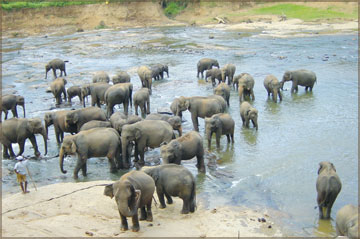Elephants an attraction and pride to Sri Lanka
by Rosanne Koelmeyer Anderson
A stunningly rich island, a haven to many a traveller and tourist is
our Lassana Sri Lanka which has much to offer. Among the many
attractions are the wonderful elephants in Sri Lanka, a passion which
runs deep down for long ages.
Sri Lankan elephants known as Aliya (tusker) by local people and the
Asian Elephant (Elephas maximus maximus) are one of the few remaining
mega-herbivores in the world constituting to around seven per cent of
the global elephant population.
The most loved animal by Sri Lankans, fascinating in its behaviour,
of national value is one of Sri Lanka's biggest tourist attractions even
today. If you are a wildlife enthusiast making a trip to Pinnawala is a
fascinating experience one should not miss out on.

The Pinnawala Elephant Orphanage is of course the first of its kind
in the world, a unique place where abandoned and even disabled elephants
get lot of care and protection making it one of the world's best
elephant breeding centers as well.
Getting to Pinnawela before 10 a.m. is important as it is at this
time that all the activities begin. Availing yourself of the opportunity
you could get a closer look at the elephants if you relax by the river,
indulge in chatting with the mahouts and observer the elephants bathe,
play and interact with each other as well as with human beings.
Indulging in a conversation with mahouts would prove to be very
informative too as they would tell you all you want to know about
elephant habitat. A cap or parasol is an absolute must as the scorching
hot sun is unbearable.
If you are however interested in looking for the aliyas in the wild
then the best bet is to go over to the Yala National Park, Udawalawe,
Habarana, Dambulla, Sigiriya, Wasgamuwa, Galoya, or Thanamalwila.
The Minneriya National Park, is another wonderful location to
observer elephants. A hot spot for wildlife lovers, Minneriya is famous
for two things,for the great Minneriya tank built by King Mahasena in
the third century AD as well as its wildlife.
During the dry season (June to September), this tank is an incredible
place to observe the elephants who come in huge flocks to bathe and
graze around. This is about the best time to go over to Minneriya in my
opinion. The safaris are a great opportunity to explore.
Apart from this aspect, elephants have also drawn the attention of
everyone who visits Sri Lanka as they have been the main attractions of
Sri Lankan religious festivals as well. In an essentially Buddhist
culture, with a rich and exotic variety of wildlife and a long tradition
of conservation rooted in its 2,230 year old Buddhist civilisation,
elephants have been considered a divine animal.
To witness the uniqueness of the role played by elephants in this
aspect make a trip to Kandy and make sure you witness the Kandy Perehera
or any of the pereheras where you would see about hundred decorated
elephants parade among dancers and drummers carrying caskets containing
sacred relics in procession.
The pereheras are the most colourful pageants and have been conducted
for over 2500 years, a kaleidoscope of colour and Asia's biggest
cultural happening for over 1000 years.
Significantly, in Sri Lanka no other animal has been associated for
so long with the people in their traditional and religious activities as
the elephant. The association dates back to the pre-Christian era, more
than 5,000 years when ancient Sinhalese kings captured and tamed
elephants .
Elephants, today still take part in ceremonial, cultural and
religious pageants and processions. Elephants have been used by man in
his wars in Europe and Asia. They have assisted man in his logging
operations and construction works.
In Sri Lanka the variations in physical appearance amongst elephants
were noticed and recorded in ancient Sinhala manuscripts. There are ten
such groups or "castes". These differences do not seem important now.
The first record of the association between man and elephant in Sri
Lanka was recorded in the 1st Century BC on an inscription at Navalar
Kulam in Panama Pattu in the Eastern Province and the ruins of the
ancient cities in Sri Lanka abound with carvings of elephants in many
forms, attesting the close association between man and elephant.
Sinhala literature of the 3rd Century BC indicates that the state
elephant or Mangalahatti was the elephant on which the king rode while
in the 12th Century inscription on a stone seat at Polonnaruwa it is
recorded that King Nissanka Malla sat upon it while watching elephant
fights.
These fights were staged for the entertainment of nobles. The first
description of the capture of elephants in 40 AD was by Pliny. Here, the
information that he gathered was from the Sinhalese ambassador to the
court of the Emperor Claudius. Hence, the importance and significance of
the elephant in Sri Lanka.
[email protected] |
